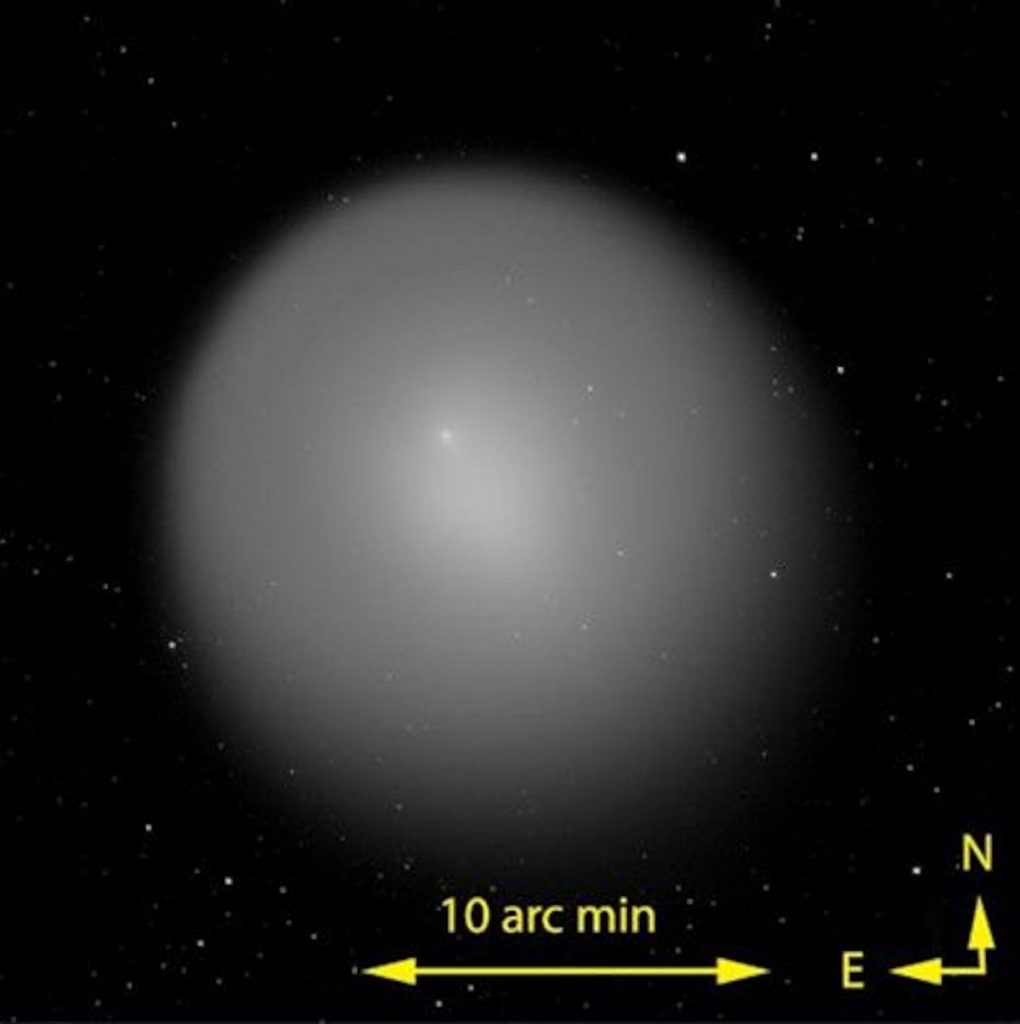The dust trail from the largest comet outburst ever seen will grace the skies this summer — and it’s going to look like a giant hourglass.
The night show will come courtesy of comet 17P/Holmes, which in October 2007 let off a huge flash of gas and dust, brightening by a factor of a million and briefly becoming the largest object in the solar system. In that brief period, its coma, the dust cloud surrounding the comet body, had a bigger diameter than the sun.
At first, it seemed that the particles given off in this record-breaking outburst might simply disperse into space, Maria Gritsevich, a planetary scientist at the University of Helsinki in Finland, told Live Science.
Now, a new model of the comet’s dust trail, described in a study by Gritsevich and her colleagues, finds that the dust trail has, instead, persisted. The particles left behind by the outburst zing in an elliptical orbit between the original outburst point and a point at the opposite side of the dust trail’s journey around the sun, which is visible from the Southern Hemisphere.
In 2022, the particles are again accumulating near the outburst point, meaning the dust trail will be visible from the Northern Hemisphere, even to hobbyist stargazers.
“Now telescopes are so good that any relatively modest system will do it,” study lead author Gritsevich told Live Science.
Related: Largest comet ever discovered bumps Hale-Bopp from its pedestal (opens in new tab)
Orbital outburst
Comet 17P/Holmes orbits between Mars and Jupiter. English astronomer Edwin Holmes first discovered it in 1892, when it flared with an outburst large enough to catch his eye while he was observing the Andromeda galaxy. The 2007 outburst was even bigger.
“Other comets in similar orbits around the sun do not produce this kind of large periodic outbursts, so the 17P/Holmes itself is probably special,” study co-author Markku Nissinen, an astronomer with the Finnish Ursa Astronomical Association, wrote in an email to Live Science.
No one knows exactly how the comet produces such dramatic outbursts, but they may happen when subsurface ice in the comet body transitions from a disorganized amorphous arrangement to a structured crystalline arrangement. This transition releases gas from within the ice, creating an outward pressure on the comet’s surface. The result is an eruption of ice, gas and dust. (That this happens without blowing the comet to bits is “remarkable,” Nissinen noted.)
In the new study, published in the Monthly Notices of the Royal Astronomical Society (opens in new tab), the researchers modeled the physics of the dust trail to understand how its initial shape led to the orbit observed today.
Trail of dust
Combining observations from the Northern and Southern Hemispheres with an understanding of how gravity and the solar wind act on differently sized particles, the researchers traced the dust trail’s path over time. As they travel, the particles sort themselves by size due to the effects of gravity and solar wind, generally arriving at the two nodes in their orbit in the order of medium, large, and small. The dust also travels in a subtle hourglass shape, with two bulges of dust on either side and a narrowed zone of dust in the middle, a relic of the initial spherical burst of dust from the comet body.
The particles are tiny, down to fractions of a millimeter in size, but they reflect the light of the sun, making them visible with the help of a telescope as a fuzzy trail in the night sky. (The trail has been visible before, including from the Northern Hemisphere in 2014 and 2015, but its brightness varies depending on how the particles catch the sun.) There has already been one report from an amateur astronomer in Finland who captured photos of the trail in February and March, Gritsevich said. Other Northern Hemisphere observers will have a chance to look for the trail in late July or after, once the particles come out of the sun’s glare, Nissinen said. The convergence point where the particles gather is in the constellation Pegasus.
Modeling the dust trail may help astronomers one day study comets up-close and personal, Gritsevich said. With a precise map of where the dust from the comet is, scientists could launch spacecraft to collect material, an easier proposition than intercepting and sampling the comet itself. She and her colleagues now plan to model the dust trail of the original 1892 outburst in hopes of finding the dust from that event.
The comet has not experienced an outburst since 2007, and it’s impossible to say when the next outburst will come, Nissinen said. 17P/Holmes let off back-to-back outbursts in 1892 and 1893, so it’s capable of erupting at any time. The comet will next swing closest to the sun again on January 31, 2028.

